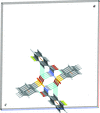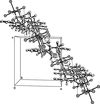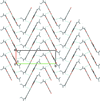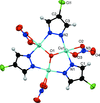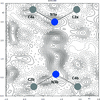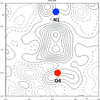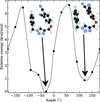issue contents
April 2016 issue

Cover illustration: The conformation of C18H13N5O in the solid-state is quite different from that predicted by energy-minimization calculations for an isolated molecule, which may be related to the balance between intramolecular and intermolecular interactions. Further insight into the packing is provided by a Hirshfeld surface analysis. See: Shamsudin, Tan, Young, Jotani, Otero-de-la-Roza & Tiekink [Acta Cryst. (2016). E72, 563-569].
research communications
Download citation


Download citation


In the title compounds, N—H⋯O hydrogen bonds lead to dimers; the dimers are linked by weak interactions into a three-dimensional network in one case and chains in the other.
Download citation


Download citation


In the crystal of the title complex salt, the amidinium cations and the centrosymmetric ZrIV complex anions are linked by N—H⋯Cl hydrogen bonds, forming a two-dimensional network extending along the b-axis direction.
CCDC reference: 1454857
Download citation


Download citation


The hydrochloride salt of isonicotinamide has been synthesized from a dilute solution of hydrochloric acid in acetonitrile and displays monoclinic symmetry (space group C2/c) at 150 K, similar to the related hydrochloride salt of nicotinamide. An array of hydrogen-bonding interactions, including a peculiar bifurcated pyridinium–chloride interaction, results in linear chains.
CCDC reference: 1455942
Download citation


Download citation


An amino-functionalized chiral metal–organic framework with (10,3)-a topology has been constructed via the assembly of the achiral triconnected building block pyridine-3,5-dicarboxylate and a triconnected CuII centre.
CCDC reference: 1456364
Download citation


Download citation


The title compound consists of a mononuclear AgI complex, a discrete binuclear AgI complex, acetate anions, acetonitrile solvent molecules and water molecules. The molecular components are linked through O—H⋯O, N—H⋯O and O—H⋯S hydrogen bonds, forming a chain structure along [100].
CCDC reference: 1452047
Download citation


Download citation


The asymmetric unit of the title compound consists of one [Eu(C3H7NO)8]3+ complex cation and one α-Keggin-type [PMo12O40] polyanion. Cations and anions are linked through C—H⋯O hydrogen bonds.
CCDC reference: 1456619
Download citation


Download citation


The title pyridopyrrolopyrimidine derivative is almost planar, with the benzene ring of the 4-nitrobenzylidene substituent inclined to the mean plane of the 8,9-dihydropyrido[2,3-d]pyrrolo[1,2-a]pyrimidin-5(7H)-one moiety by 6.8 (1)°.
CCDC reference: 1456732
Download citation


Download citation


Four independent CrIII ions are present in the title structure, each situated on an inversion centre and with a distorted octahedral coordination sphere by six N atoms (four from a cyclam ligand in the equatorial plane and two in axial positions). The crystal packing is stabilized by extensive hydrogen-bonding interactions between the molecular and ionic moieties.
CCDC reference: 1456673
Download citation


Download citation


The sesquiterpene molecule has been isolated from Indian herb A. reticulata by column chromatography over silica gel with a mixture of binary solvent ethyl acetate and hexane by gradient elution. It was recrystallized at room temperature by slow evaporation to afford suitable crystal for X-ray diffraction study. Antiproliferative bioassay of this molecule has been conducted against human ovarian cancer cell line A 2780.
CCDC reference: 1455684
Download citation


Download citation


The title furanocoumarin, isolated from the Indian herb A. reticulata, crystallizes with two independent molecules (A and B) in the asymmetric unit. The two molecules differ essentially in the orientation of the propenyl group at the 2-position with respect to the mean plane of the furanocoumarin moiety. In the crystal, the two molecules are linked via O—H⋯O hydrogen bonds forming zigzag –A–B–A–B– chains propagating along [001].
CCDC reference: 1422810
Download citation


Download citation


The approximately planar (E,E)-2′,4′-dihydroxyacetophenone azine molecule is located on an inversion centre and linked with dimethylformamide solvent molecules via O—H⋯O hydrogen bonds.
CCDC reference: 1457201
Download citation


Download citation


The crystal structure of bis{bis(azido-κN)bis[bis(pyridin-2-yl-κN)amine]cobalt(III)} sulfate dihydrate is comprised of discrete [Co(dpa)2(N3)2]+ cations, SO42− anions and solvent water molecules in a 2:1:2 ratio; extensive hydrogen-bonding interactions link the species into a three-dimensional supramolecular framework.
CCDC reference: 1457112
Download citation


Download citation


The crystal structures of two bromo–hydroxy–benzoic acid derivatives, namely, methyl 4-bromo-2-(methoxymethoxy)benzoate, (I), and 4-bromo-3-(methoxymethoxy)benzoic acid, (II), are compared. Compound (II) crystallizes with two independent molecules in the asymmetric unit. In the crystal structures of both compounds, two-dimensional architectures are formed principally by C—H⋯O hydrogen bonds, and by Br⋯O interactions in (I) and by π–π interactions in (II).
Download citation


Download citation


The title salts, C4H7N2+·NO3−·C4H6N2, (I), and C4H7N2+·NO3−, (II), are composed of hydrogen-bonded chains along [001] and [100] for (I) and (II), respectively.
Download citation


Download citation


The title complex is a centrosymmetric dimer with a copper–copper distance of 4.0408 (3) Å. The Cu ions in the dimer are bridged by two triazole rings and oxygen donor ligands from water molecules and nitrate anions in a distorted octahedral coordination geometry.
CCDC reference: 1456451
Download citation


Download citation


The crystal structure of the novel Pb/Cr heterometallic complex with 2-(dimethylamino)ethanol prepared by direct synthesis is reported.
CCDC reference: 1460850
Download citation


Download citation


The cuprate anion in the title compound is located about a threefold rotation axis and hence forms an almost planar Cu3(μ3-O)-core, where the μ3-O atom is located 0.12 Å above the Cu3 plane.
CCDC reference: 1458061
Download citation


Download citation


Tetrasodium hepta(cobalt/aluminium) hexa(arsenate/phosphate) is a new member of the isostructural family of compounds with the general formula A4M7(XO4)6 (A: Na, K; M: Ni, Co; X: P, As). The proposed structural model is based both on a careful investigation of the crystal data, as well as validation tools by means of bond-valence-sum (BVS) and charge-distribution (CHARDI) calculations.
CCDC reference: 1462882
Download citation


Download citation


The CoII atom in the crystal structure of diaquabis(N,N-diethylnicotinamide)bis(2,4,6-trimethylbenzoato)cobalt(II) is located on an inversion centre and exhibits a slightly distorted octahedral N2O4 coordination set. Hydrogen bonds of the type O—H⋯O and C—H⋯O lead to the formation of a three-dimensional network.
CCDC reference: 1462884
Download citation


Download citation


The title salt, [Mn(C4H11NO2)2](C7H6NO2)2, contains a centrosymmetric cation with the Mn2+ ion coordinated octahedrally by two tridentate diethanolamine (DEA) ligands. The cations are connected to the anions through O—H⋯O and N—H⋯O hydrogen bonds into a three-dimensional network structure.
CCDC reference: 1463701
Download citation


Download citation


The synthetic spinel Li0.64Fe2.15Ge0.21O4 shows a partially inverse cationic arrangement with Ge4+ on the tetrahedral sites and Li+ on the octahdral sites. Iron is in the trivalent state and is distributed over both type of sites.
CCDC reference: 1463892
Download citation


Download citation


The title structure has been redetermined from the data published by Benali-Cherif, Falek & Direm [Acta Cryst. (2009), E65, o3058–o3059]. The improvement of the present redetermination consists in the discovery of the disorder of one of the H atoms with occupancies equal to 0.55 (2) and 0.45 (2), respectively. These H atoms are involved in an N⋯N hydrogen bond and are shifted towards its centre.
CCDC reference: 1459296
Download citation


Download citation


The title structure, 2-amino-4,6-dimethoxypyrimidine-(μ2-hydrogen)-4-aminobenzoate, has been redetermined from the data published by Thanigaimani, Muthiah & Lynch [Acta Cryst. (2006), E62, o2976–o2978]. The improvement of the present redetermination consists in a released geometry of the primary amine groups, which were originally been assumed as planar, as well as in a redetermination of the position of the hydroxy H atom. This H atom, whose parameters were originally constrained, turns out to be situated about the centre of the O⋯N hydrogen bond in two disordered positions, each with 0.5 occupancy.
CCDC reference: 1465363
Download citation


Download citation


Two almost planar residues in the title thione are orientated perpendicularly [dihedral angle = 82.72 (5)°]; the conformation about the imine bond is E. In the crystal, centrosymmetric aggregates are formed via {⋯HNCS}2 synthons which are linked into supramolecular layers by C—H⋯O interactions.
CCDC reference: 1465209
Download citation


Download citation


The title compound consists of a substituted 2-[(E)-2-arylethenyl]-3-arylquinazolin-4(3H)-one skeleton. The substituents at the ethylene fragment are located in trans positions. In the crystal, molecules are connected via O—H⋯O hydrogen bonds forming a 21 helix propagating along the a-axis direction.
CCDC reference: 1468806
Download citation


Download citation


The complex cation of the title salt, [Cd(C6H15NO3)2](C9H6NO3S)2, has a CdII atom coordinated in a bicapped trigonal–prismatic fashion by two tetradentate triethanolamine (TEA) ligands. The supramolecular interactions between cations and anions lead to a two-dimensional network structure parallel to (001).
CCDC reference: 1468939
Download citation


Download citation


In the title compound, the hydrogen phosphate anions are linked by O—H⋯O hydrogen bonds into chains parallel to [100]. The inorganic anionic chains and the organic cations are linked by N—H⋯O and N—H⋯N hydrogen bonds, forming a two-dimensional supramolecular network extending parallel to (001).
CCDC reference: 1469440
Download citation


Download citation


In the title compound, [Pd(C11H9N)(C13H14N2)Cl2], the PdII ion is coordinated by two Cl anions, one carbene C atom and one pyridine N atom in a slightly distorted square-planar geometry. In the crystal, the molecules are linked through weak C—H⋯Cl hydrogen bonds into a tape structure.
CCDC reference: 1468135
Download citation


Download citation


Trinuclear nickel complexes have been isolated and characterized. These complexes resulted from reaction with the constrained α–β dioxime congener of phenanthrene-9,10-dione.
Download citation


Download citation


Bis[2-(pyridin-2-yl)phenyl]rhodium(III) complexes bearing acetonitrile or monodeprotonated thyminate (Hthym−) were characterized by X-ray analysis, and in the latter complexes it was revealed that Hthym− coordinated to an RhIII centre through the N1 atom together with a hydrogen-bonded methanol or ethanol co-ligand in the cis position.
Download citation


Download citation


The one-dimensional coordination polymer, self-assembled from bis(acetylacetonato)cobalt(II) units as metal–complex connectors and 1,4-diazabicyclo[2.2.2]octane (DABCO) as linkers, can serve for a comparative investigation of the magnetic behaviour of analogous compounds. Space filling more symmetric than atom positions leads to pronounced orientational disorder for the DABCO ligand.
CCDC reference: 1454848
Download citation


Download citation


The asymmetric unit of the title compound comprises two independent 5-fluorocytosine molecules and one half-molecule of melamine. The 5-fluorocytosine molecules are linked through two different homosynthons; one is formed via a pair of N—H⋯O hydrogen bonds and the second via a pair of N—H⋯N hydrogen bonds. The 5-fluorocytosine and melamine molecules interact via N—H⋯O, N—H⋯N and N—H⋯O, N—H⋯N, C—H⋯F hydrogen bonds.
CCDC reference: 1469709
Download citation


Download citation


In the title compound, two imidazolyl groups are separated by a zigzag –CH=N—N=CH– linkage. Each molecule forms four N—H⋯N hydrogen bonds with two neighbouring molecules to constitute a one-dimensional ladder-like structure along the a axis.
CCDC reference: 1468833
Download citation


Download citation


The crystal structure of the title compound shows that the 1,2-diaminocyclohexane fragment has a chair conformation with the N atoms in an antiperiplanar conformation. The packing is stabilized via N—H⋯Br, C—H⋯Br and C—H⋯π interactions.
CCDC reference: 1469040
Download citation


Download citation


The terminal rings in the title compound have an anti disposition in contrast to a syn conformation calculated in the energy-minimized structure. Supramolecular layers in the ab plane and sustained by methylene-C—H⋯N(triazolyl) and carbonitrile-N⋯π(benzene) interactions feature in the molecular packing.
CCDC reference: 1469592
Download citation


Download citation


The title compound, which comprises an isoquinolinium cation and 5-(2,4-dinitrophenyl)-1,3-dimethylbabriturate anion, exhibits anticonvulsant and hypnotic activities. 3D Hirshfeld surface analysis establishes the predominant O⋯H/H⋯O intermolecular contacts in the crystal lattice.
CCDC reference: 1444879
Download citation


Download citation


The crystal structures of three N-(arylsulfonyl)-4-fluorobenzamides, namely 4-fluoro-N-(2-methylphenylsulfonyl)benzamide, (I), N-(2-chlorophenylsulfonyl)-4-fluorobenzamide, (II), and N-(4-chlorophenylsulfonyl)-4-fluorobenzamide monohydrate, (III), are described and compared with related structures. The conformation of the three molecules is very similar with the aromatic rings being inclined to one another by 82.83 (11) and 85.01 (10)° in the two independent molecules of (I), 89.91 (10)° in (II) and 81.82 (11)° in (III).
Download citation


Download citation


Enantiopure imines synthesized starting from 2-naphthaldehyde and chiral liquid amines were characterized by X-ray diffraction.
Download citation


Download citation


The title molecule consists of an Re(CO)3+ fragment, an aqua ligand and one N,O-chelating valinate anion to complete a slightly distorted coordination sphere.
CCDC reference: 1469075
Download citation


Download citation


The extended structure consists of infinite [010] chains linked by Ow—H⋯O (w = water) hydrogen bonds. These chains are cross-linked by the dications via N—H⋯Ow and weak C—H⋯O hydrogen bonds, thus forming a three-dimensional supramolecular network. Three-dimensional Hirshfeld surface analysis and two-dimensional fingerprint maps reveal that the structure is dominated by H⋯O/O⋯H and H⋯H contacts.
CCDC reference: 1470800
Download citation


Download citation


In the title compound, the symmetry-unique terminal CuII ion is O,N,N′-coordinated by a 2-{[(2,2,6,6-tetramethylpiperidin-4-yl)imino]methyl}phenolate ligand and an O atom from an acetate group in a slightly distorted tetrahedral coordination environment. The symmetry-unique central CuII ion is coordinated by a different O atom of the same acetate group and by four bridging acetate ligands, which connect the asymmetric unit into a dimeric complex and form a slightly distorted square-pyramidal coordination environment.
CCDC reference: 1470356
Download citation


Download citation


The geometry of the title hemibiquinone is different from previous examples and may be correlated with the weak interactions in the crystal.
CCDC reference: 1470649


 journal menu
journal menu











